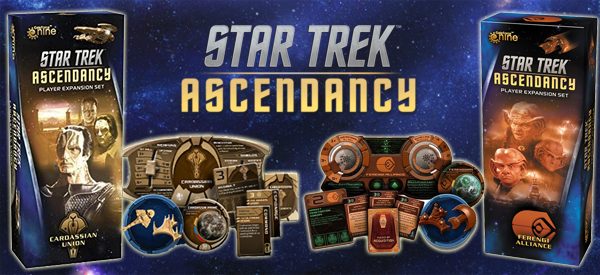
It took forever for me to get a chance to play Star Trek: Ascendancy, thanks in large part to its hard three-player limit. I had a feeling that I would really enjoy the game when I first opened it up and skimmed through the rules. A good Star Trek-themed 4-x game is something that I've been craving since Birth of the Federation on Windows 98. Sure enough, after playing Ascendancy, it immediately became my favorite Star Trek board game on the market. The friends that I've played it with have also all loved it so far.
The base game included an insert advertising the first two expansions: the Cardassians and Ferengi. After the first play-session, I put the two expansions on my wishlist. Each expansion adds an additional faction and support for an additional player (for up to five, if you have the friends and the time). The Borg expansion came out around the same time, and I picked that one up too, as I was curious to see how the NPC Borg faction would play out. We decided to stick with the more basic expansions first though, as the Borg added extra complexity (and difficulty) that we weren't sure we were ready for. So I'll be reviewing the Borg seperately.
Star Trek: Ascendancy came packaged with an insert for the Cardassian and Ferengi expansions.
I had hoped to get a review of the Ferengi, Cardassians, and Borg out last year. And I don't mean like "in December" last year; I mean I had hoped to have this review out last February! Unfortunately, the difficulty inherent in getting four or five people together to play a six-hour board game, combined with packing up the house and moving last summer, meant that I got a couple early games in with the Cardassians, but never got a chance to play as the Ferengi until this winter. I didn't want to write a review of one faction without playing the other, since they are kind of inversions of each other in many ways.
The core game comes packaged with turn order cards for up to ten players, so I initially guessed that meant that Gale Force 9 was anticipating at least seven expansions. The Vulcans and Andorians will be released imminently, and the Borg rules actually allow the Borg to use up two turn order cards, which means there's only one space left to fill! Judging by the cards present in the base game, it looks like the Tholians are set to be the last expansion. If that's the case, this would leave some significant players on the Star Trek galactic stage out in the cold. The Dominion would be the single, most conspicuous absence from the game's roster. I also had hoped to see the Gorn as a faction, and at least one Delta Quadrant faction (such as the Kazon or Hirogen).
Well, I can take a guess what the next (hopefully not last) planned expansions is...
Though, I guess there's nothing stopping Gale Force 9 from releasing more expansion factions than there are turn order cards. I mean, I doubt anybody's going to be playing this game with nine or ten players anyway. Good luck finding a table big enough to even play such a game to begin with! GF9 could also just package an eleventh or twelfth turn order card in any future expansions if they feel it's necessary. So there's no reason why they would be unable to release the Dominion, Gorn, or other factions.
In any case, the first three expansions complete the Birth of the Federation roster of playable Federation, Klingons, Romulans, Ferengi, and Cardassians, as well as an NPC Borg faction.
There's not much in the way of new rules for either of the new factions. Both come with 10 new system discs (including the faction's respective homeworld), all the faction's ships and control nodes, advancement decks, some extra resource nodes and tokens, and ten new exploration cards. Everything slots pretty seamlessly into the core game. The only new mechanics are associated with some of the new exploration cards in the Ferengi expansion, but the card texts are pretty self-explanatory. There's a tiny rules insert anyway, in case you need more clarification.
I was expecting a Dominion expansion, and had hoped for the Gorn and at least one Delta Quadrant faction.
The seamless integration and lack of new rules does not, however, mean that the new factions feel dull or uninteresting. In fact, both the Cardassians and Ferengi have a very distinct (and very fresh) feel of play. Both have very potent unique boons and banes that separate them tremendously from the three factions included in the core set. In general, they both are dependent on using their ships and fleets to fuel their respective economies, which gives their ships uses beyond just exploration, research, and military action. You have to be very deliberate with your ships and fleets, since proper use is essential to keeping your economy running. As such, I don't recommend that a novice player jump into playing as either the Cardassians or Ferengi. You could probably muddle your way along, but it's better to have a firm grasp of the game mechanics (playing as the Klingons or Romulans) before you try your hand at the expansions.
... [More]
8ba34ba0-cafd-4866-80a3-5fab9c90eeb7|0|.0
Tags:Star Trek, Star Trek: Ascendancy, Gale Force Nine, board game, expansion, Cardassian, Ferengi, labor camp, production, occupation, invasion, trade, culture
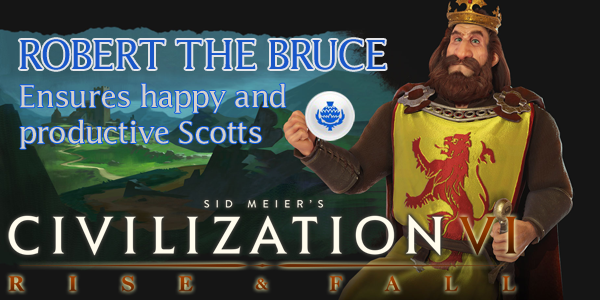
Civilization VI's second expansion, Gathering Storm was announced earlier this year, and will be released in a couple months. It will include modified rules and new civilizations, and I'll certainly be writing some guides for its new civilizations. In the meantime, however, I'm going to tackle one more civilization from the previous Rise & Fall expansion. This civilization happens to be the last of the "new" civilizations (a civ that has never appeared in a previous game): Scotland, lead by Robert the Bruce.

Scotland is currently a part of the United Kingdom, and makes up the northern third of the British isle. However, Scotland was an independent, sovereign kingdom throughout most of the Middle Ages. The lands of Scotland are shaped predominantly by receding glaciers during the tail end of the last ice age, and the area has been inhabited for over twelve thousand years. The Scottish Gaels strongly resisted Roman encroachment into their territory during the first and second centuries. Their raids on Roman forts forced emperor Hadrian to construct a defensive wall over 117 km long and as tall as 6 meters, that ran almost the entire width of the island. Parts of the wall still stand across England today. After the withdrawl of the Romans, the kingdom of the Picts became known as the kingdom of Alba, which flourished in the 12th and 14th centuries, possessing some of Europe's most influential philosophers.
In 1295, when Scotland's King John had refused to fight alongside England's King Edward against the French -- despite Edward having arbitrated the Scottish crown to John -- England and Scotland were plunged into war that resulted in England seizing control over Scotland. In the early 14th century, new Scottish King Robert the Bruce began a 20-year campaign against the English to restore Scottish independence. Victory at the battle of Bannockburn finally restored control of Scotland back to the Scotts, and conflict between England and Scotland continued off and on for many generations before the two countries were united diplomatically in 1707.
DISCLAIMER:
Civilization VI is still a "living game". Strategies for the game (and for specific leaders and civs) may change as Firaxis applies balance patches, introduces new features, or expands the game through further DLC or expansion packs, or as the Civ community discovers new strategies or exploits. As such, the following strategy guide may change from time to time. I will try to keep it up-to-date, and will make notations whenever changes are made. I'll also post links in the official 2K forums and CivFanatics, where I'll also report any changes made. If possible and practical, I will try to retain the original content of the strategy for posterity.
I welcome any feedback or suggestions that readers wish to offer. Feel free to post on the linked forums, or by posting a comment at the bottom of the page.
This guide is up to date as of the November 2018 "launcher" patch (ver. 1.0.0.262)
Scotland is another "world police" civ (similar to Australia). It can also hold its own and can become a technological and/or industrial powerhouse if its citizens remain happy.
[More]
4aff6e58-76c7-40e2-879e-064cb4e5c5c2|0|.0
Tags:Sid Meier's Civilization, Civilization VI, Civilization VI: Rise and Fall, Scotland, Scottish Enlightenment, Robert the Bruce, Bannockburn, golf course, highlander, flower of Scotland, ranger, amenity, happiness, housing, science, production, culture, war of liberation, casus beli, alliance, city state, unique improvement, unique ranged unit
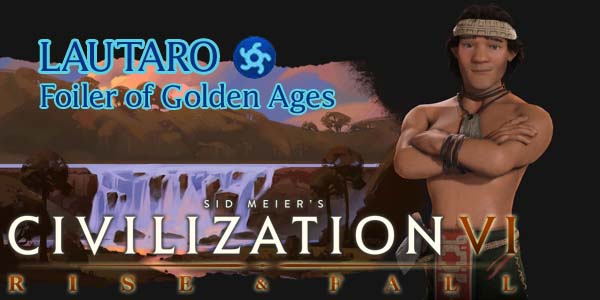
Civilization VI's first expansion, Rise & Fall released earlier this year, and it introduced a few leaders and civilizations that are making their first appearance in the franchise. I hope to be able to write strategies for every one of the expansion civs and leaders, but I'm going to start with the ones that are new to the franchise, and the ones that most utilize the expansion's new features (Era Score, governors, loyalty, and so on). This month, I will be tackling the Mapuche, lead by Lautaro.
The peoples known as the Mapuche are a collection of societies indigenous to southern Chile and Argentina who are linked by social, spiritual, economic, and linguistic heritage. Archaeological evidence shows their culture has existed since around 600 or 500 BC, and their textiles have been traded throughout South America for centuries. Though mostly independent, the various tribes would unite together during times of war (such as against the Inca and Spanish) and elect a "toqui" (meaning "axe-bearer") to act as a military and domestic leader.
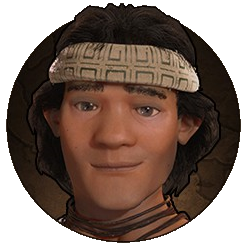
One such toqui was Lautaro "Swift Hawk". He was elected toqui while still less than 20 years old, after escaping from the personal captivity of the Spanish general Pedro de Valdivia. He lead numerous successful raids (called "Malón") against the Spanish, eventually capturing Fort Tucapel in December and killing his former captor, de Valdivia, during the Spanish counterattack in December 1553. The Mapuche, under Lautaro's command, may have been able to further expel the Spanish if not for a typhus outbreak and famine that prevented further raids. He was killed four years later in a Spanish ambush, but the Mapuche would continue to resist the Spanish for over a century after Lautaro's death. Lautaro is revered by Chileans (Mapuche and non-Mapuche alike) for his courageous leadership against the Spanish who sought to enslave them, and is even depicted as an almost heroic figure in the Spanish epic poem La Araucana.
Lautaro and the Mapuche can be a potent military force in Civilization VI: Rise & Fall, especially against rival civilizations that ascend to golden ages, or who fall into dark ages.
[More]
a95ca795-d055-4cea-94db-0c1f2aeff1de|0|.0
Tags:Sid Meier's Civilization, Civilization VI, Civilization VI: Rise and Fall, Mapuche, Lautaro, Toqui, Swift Hawk, Spirit of Tucapel, Malon Raider, Chemamull, loyalty, golden age, dark age, culture, appeal, tourism, cavalry, light cavalry, pillage, Chile, unique improvement, unique mounted unit

Sid Meier's Civilization computer game seems ripe for conversion into a board game. The PC game is, after all, basically just a computerized board game that plays out on a grander scale. Sid himself was inspired by many classic board games, including Risk and Axis & Allies. Fantasy Flight has already taken a stab at trying to distill the core mechanics of Civ down into a digestible board game when they released Sid Meier's Civilization: the Board Game back in 2010. I really like that game, even though it is a bit bloated and unwieldy. Attempting to directly translate Civ's mechanics down into board game form unsurprisingly results in a fairly complicated game that takes a very long time to learn and play.
Fantasy Flight's approach this time around seems to be to develop an elegant board game, and then apply the Civilization license onto it. The result is a board game that feels much more distant from the computer game, but which plays much more smoothly as a board game.
Civilization, streamlined
Perhaps the biggest problem with the older Civilization board game is the game length and amount of downtime. Games could run for over five hours, and the fact that each player resolved their entire turn phase (city management or army movement) before moving onto the next player meant that you could end up sitting for 20 to 40 minutes, twiddling your thumbs and waiting for other players to resolve their turns. That is one of my biggest peeves with a lot of epic games: too much downtime.
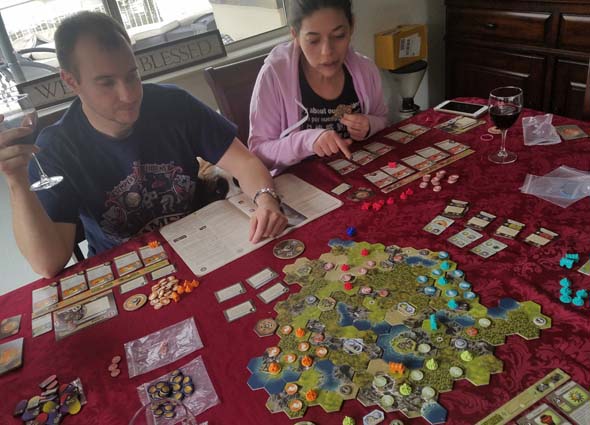
A New Dawn is a very elegant game.
A New Dawn addresses that problem by having each player take only a single action in each of their turns. There are no phases; just take an action from your focus bar and then move on to the next player. Turns, therefore, are very quick, turnaround time is very short, and the game moves along at a rapid pace. This, ironically, serves to better maintain the "one more turn" addictive nature of the computer game. You might find yourself neglecting bathroom breaks for several turns because things are moving along so swiftly. Your turn is generally quick enough that you want to finish it before you step away or take a break, and other players' turns are so quick that you don't want to step away because you know it'll be back around to your turn in a few minutes.
Longer games with longer turns and more downtime can also often result in players outright forgetting what they were planning on doing by the time the turn gets back around to them. Either that, or the large amounts of moves and actions that the other players take changes the game state so much that, when your turn comes around, the thing you were planning on doing is no longer ideal -- if it's even possible.
That's rarely a problem in A New Dawn because each player does one thing on their turn, so the state of the board isn't radically changing between your turns. It's much more of a gradual change. That doesn't mean that other players can't disrupt your plans; they certainly can, especially when combat between players starts happening. It just means that you aren't going to be sitting there bouncing up and down in your chair waiting to pull off a spectacular move, only to have another player blow up all your plans at the last minute and leave you spending far too long wondering "What the heck do I do now?" when your turn starts... [More]
67fd088c-265a-4a60-939d-4c4027df3179|0|.0
Tags:Sid Meier's Civilization, Sid Meier's Civilization: A New Dawn, Sid Meier's Civilization the Board Game, Fantasy Flight, Firaxis, 2K Games, board game, strategy, empire-building, focus bar, cities, world wonder, technology, culture, war, barbarians, James Kniffen
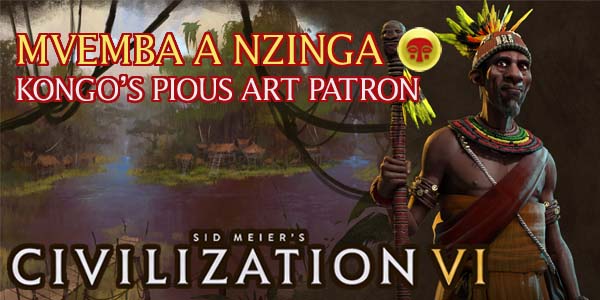
The Kingdom of Kongo was a small, but prosperous kingdom located on the west coast of sub-Saharan Africa. It can trace its origins back to the late 14th century, when Lukeni lua Nimi conquered the city of Mwene Kabunga and renamed it M'banza-Kongo. The city grew rapidly in an otherwise sparsely-populated region, and by the 17th century, it contained about one-fifth of the entire Kongo population (around 100,000 people). It's large population made it a prosperous and wealthy trading hub that eventually attracted the attention of European powers. The Portuguese set up colonies in Kongo territory, where they would set up a Roman Catholic church that would become one of the strongest churches in all of Africa. In 2017, the entire city of M'banza-Kongo was declared a UNESCO World Heritage Site.

In the first half of the 16th century, Kongo was ruled by Mvemba a Nzinga. His father converted to Christianity following the arrival of the Portuguese, and Mvemba a Nzinga added "Afonso" to his name, later becoming known as King Afonso I of Kongo. Afonso played a leading role in Kongo's conversion to Christianity and helped to establish and promote the Roman Catholic Church in the region. The reasoning for his conversion is unclear. Some scholars believe that he was motivated by genuine faith; while others believe that he was only complicit in the conversion in order to facilitate trade with European powers, and possibly to try to spare his population from becoming subject to the Atlantic slave trade. While Kongo had a slave economy of its own, and the kingdom willingly sold slaves to the Europeans, Afonso still denounced the Portuguese as exploiting Kongo's cooperation by kidnapping free Kongo citizens in violation of Kongolese law. The King of Portugal responded by dispatching officers to oversee the slave trade and ensure that only lawful slaves were sold to Europeans, and he demanded additional tribute from Kongo, such as wines and grains.
DISCLAIMER:
Civilization VI is still very early in its life-cycle. Strategies for the game (and for specific leaders and civs) may change as Firaxis applies balance patches, introduces new features, or expands the game through DLC or expansion packs, or as the Civ community discovers new strategies. As such, the following strategy guide may change from time to time. I will try to keep it up-to-date, and will make notations whenever changes are made. I'll also post links in the official 2K forums and CivFanatics, where I'll also report any changes made. If possible and practical, I will try to retain the original content of the strategy for posterity.
I welcome any feedback or suggestions that readers wish to offer. Feel free to post on the linked forums, or by posting a comment at the bottom of the page.
This guide is up to date as of the Summer 2017 patch (ver. 1.0.0.167) (Nubia DLC)
Kongo is a civilization that thrives in jungles and forest, growing massive (and productive) cities. Mvemba a Nzinga adds a unique religious flavor to the civilization by preventing it from being able to found its own religion, while simultaneously wanting other players to send their religion to you.
[More]
d42e1e83-3ee9-4f90-ab44-b8ddd956e2eb|1|5.0
Tags:Sid Meier's Civilization, Civilization VI, Kongo, Kongolese, Mvemba a Nzinga, Afonso I, Nkisi, religious convert, enthusiastic disciple, Ngao Mbeba, Mbanza, neighborhood, housing, appeal, religion, woods, rainforest, art, sculpture, archaeology, relic, artifact, museum, culture, slavery, Atlantic slave trade, unique improvement, unique melee unit, swordsman
|

| 12 | | | | | | | 60 | | 11 | | | | | | | 55 | | 10 | | | | | | | 50 | | 09 | | | | | | | 45 | | 08 | | | | | | | 40 | | 07 | | | | | | | 35 | | 06 | | | | | | | 30 | | 05 | | | | | | | 25 | | 04 | | | | | | | 20 | | 03 | | | | | | | 15 | | 02 | | | | | | | 10 | | 01 | | | | | | | 05 |
|